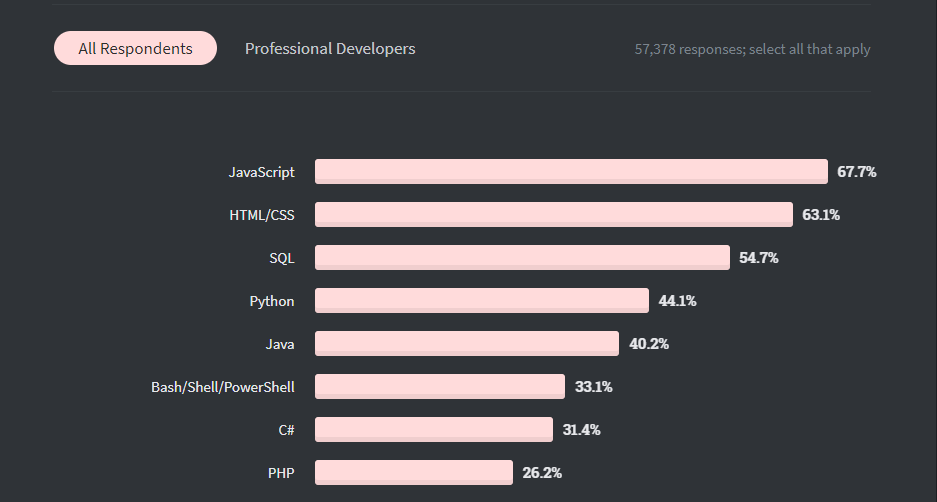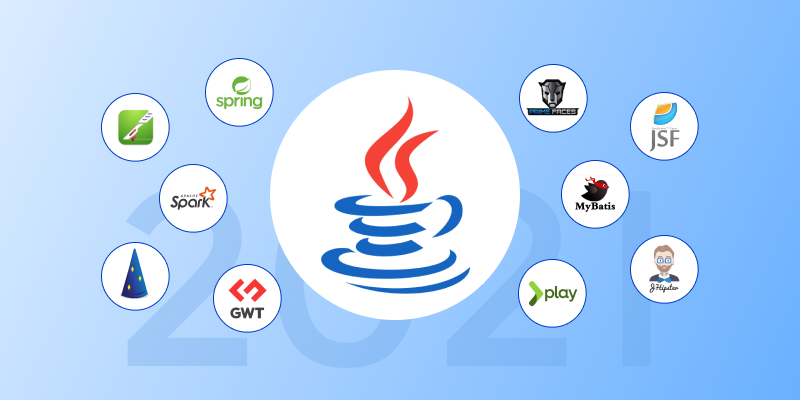Do you want to make your web development process easy? Are you frustrated with using repetitive codes? Or are you looking for the pre-written codes? Java Framework is all you need.
Development processes take days and hours-n-hours to develop any web project.
Whether you are developing a web application or software, it holds lots of coding processes. But using a framework, your work becomes easy and fast. There is a situation when you have to write the same piece of code in multiple places.
It is evident when you are doing so; you are contributing time to doing the repetitive task. So, if you want to automate your task, especially for the development process, give a try to JAVA Frameworks,
It helps in automating the development process. There are other advantages of including Java Frameworks for Web Development. Let’s see what are those advantages so that you must include them in your next web project.
But this, I would like to know you that Java is 5th most popular technology that developers are using today. According to Stackoverflow 2020 survey, 40.2% of developers around the globe are using JAVA for their web projects.

Highlights of Contents
Benefits of Using Java Frameworks For Web Development
Java Framework is similar to other frameworks; here, I mean objectives are the same. The main objective of designing a framework is to improve the efficiency of completing the task. Similarly, while doing programming, the structural application (framework) helps developers increase their coding efficiency.
- It is a pre-written code that is useful in satisfying domain-specific coding problems.
- JAVA framework provides security to your application.
- Offers tremendous support in resolving web development related issues.
- It consists of predefined functions, classes that make the development process easy and fast.
- As it makes the coding process faster, ultimately, the expenses on the project will get reduced.
Till now, we know the benefits of using the Java framework. Now we will catch up on which framework is best for Java-based projects? What is the best Java GUI framework?
Also Read: 10 Best Web Development Framework for Golang
10 Most Captivate Java frameworks For Web Development
1. Spring Framework

Spring is one of the powerful JAVA frameworks that we have in the market. It can resolve various programming issues in JAVA EE. It constitutes better programming practice like you can use interfaces besides using classes.
The framework is best known for solving enterprise application development problems. Developers can apply POJO or POJI models in their programming for the business application using Spring. Besides, it is a modular framework that holds diverse modules for various tasks, making it easy to integrate other Java frameworks.
It is an open-source framework with lightweight, allow you to use any of Spring’s modules. Supports IOC (Inversion Of Control), will enable creations of objects in runtime, and satisfying application dependencies.
Spring carries an exemplary implementation of AOP (Aspect Oriented Programming). Function on MVC model for the development process. Have their own containers that make it easy to run test cases. It consists of the Transaction Management layer. It has its own JDBC exception handling.
2. Struts

Struts is Java’s framework developed by Craig McClanahan, and later, he denoted the framework to Apache Foundation in May 2000. It is the best solution for web applications. It has a set of classes and interfaces that can fix various problems that usually come in front of developers while developing web applications.
The framework is based on the MVC model, making it easy to manage an application’s flow. It supports some important Java technologies like XML, JSP, Servlet, JSTL, etc., which helps implement MVC architecture. Strut is a ready-to-use validation framework. It has the power to integrate with other Java frameworks.
Intelligent defaults in all configuration files. Use of OGNL. Ready to use view component. Strong validation support. AJAX Functionality. Easy extendable, doesn’t require any changes in actual business logic. Promote Separation of Concerns (SoC) Minimal configuration Offers easy integration with other frameworks.
3. Hibernate

Hibernate is a Java-based ORM framework that makes database programming quick and straightforward. It promotes JPA annotations. We can configure this framework either using XML, property files, or through programming. One of Hibernate’s best things is that it overcomes all those setbacks we usually face when working at JDBC.
In Hibernate, there is an abstraction layer that looks at the internal implementations. Here internal implementations involve duties like establishing a connection with the databases and operational works like writing a CRUD query.
Features of Hibernate
- Open-source and lightweight.
- Permits operations under the ORI model.
- The internal connection with the database is made using JAVA API.
- Database dependency is roll out.
- Overcomes the object level relationship.
4. Apache Wicket

More commonly known as Wicket, this is a server-side, Java-based web application framework that makes it easy to write reusable code.
All the configuration is done in Java. No XML information is stored on the server, which is useful for many reasons. Someone can’t just download your app and use it, but then again, they can’t use it offline, so that’s a big problem.
The nice thing about Apache Wicket, being on the server, it needs a little download time. It has an AJAX object that allows you to update the Ud and remove hide and set visible easily. There is also a robust community, so you can email if you have any questions or concerns.
However, there is something special in wicked called models. Models help minimize memory, and that’s because you only want the data when you’re using it and when you’re not, you can detach the model from the UI or the database layer.
5. JSF (Java Server Faces)
JSF framework forces an immaculate MVC model. It also has an inversion of control in which the container maintains the lifecycle of its java objects. We can use either an XML file or annotations to do the configuration of things. You can make use of both concepts.
The business logic will be in POJO. The component-based user interface is really what sets JSF apart from all of those previous dynamic web content generators. In JSF, we will write abstract representations of user interface components, which means we can avoid the use of HTML, low-level HTML.
The abstractions will then convert to the appropriate representation depending upon things like what browser you are using? Or what type of devices you are using, whether it is a desktop machine, a smartphone, a tablet, the same view will be represented in different ways according to the request made. JavaServer faces is first and foremost a standard user interface component framework. It is simple and has lightweight Java classes.
6. Grails
Grails is an amazing framework that stands great for building Java-based web applications. It is open-source and is maintained by Spring source, a VMware subsidiary, a leader in virtualization and cloud computing architectures. It is valued as a full-stack model-view-controller framework. This means it has those components which are pre-integrated into the framework.
With Grails, you don’t have to write scores of XML configuration files to glue everything together. It is a model-view-controller(MVC) framework. A dispatcher runs on the webserver. The application controllers control all of the logic in your web application, such as calculating values, querying, database, etc.
Similarly, the (GORM) Grails’ Object Relational Mapping with Hibernate can help you create the database for you.
7. Play
Play is another amazing web application framework like struts spring and JSF. It also follows the MVC architecture to differentiate the Model, View, and controller logic. It’s also highly productive whenever you are creating applications by using Java.
Earlier, you need to redeploy into the server multiple times whenever you have the application’s modifications. But whenever you are using the play framework, it’s not required. It supports both Java programming language as well as Scala programming languages. If you are a Java developer, you can choose the play for Java. If you are a color developer, you can select the Play for Scala Y Play Framework.
Play Framework is very lightweight so that we can create web applications with minimal resources. It provides stateless as well as severe friendly architecture. The applications which are created by the Play Framework are highly scalable and consumes minimal resources like the CPU, memory, and RAM size.
8. Apache Hadoop
Hadoop, it’s an open-source framework for storage and large-scale processing of datasets on distributed clusters. It was developed in 2005 by Yahoo and then open source shortly after it is written in Java. It is also licensed with the Apache, License 2.0, and it solves those three V’s of Big Data volume velocity and variety.
Hadoop is a distributed architecture that scales cost-effectively to solve the volume problem. As we need more storage or computing capacity, all you need to do is add more nodes to the cluster. Hadoop allows you to store data in any format, being that it’s structured or unstructured.
With Hadoop, you get the overview of data that will be shown in your system. It is easy to load raw data into the system. Because of the system’s e flexibility, you’re able to avoid many network and processing bottlenecks associated with loading that raw data.
The system’s flexibility makes it easier to integrate any changes that mean it was designed to execute transformations and processes where the data exists.
9. GWT (Google Web Toolkit)
Google web toolkit provides a set of tools for a developer to write Ajax applications in the Java programming language. Taking advantage of all the tools available for Java and then cross-compiling that code in the highly optimized plain old JavaScript.
JavaScript is not only optimized per browser but can be served from any web server. At deploy time the source package is divided into server and client packages separately. Java files in the client directory will be cross-compiled into JavaScript and run in users’ browser files.
10. Spark
Spark is an open-source cluster computing framework created by a group of people to overcome a problem in Hadoop. It can process real-time data processing with a large amount of data, which basically Hadoop, is delaying.
However, Apache spark can do real-time data processing as well as batch processing at the same time. Initially, the Spark framework was designed and developed by some of the people from the University of California. Later on, they move that to the Apache foundation, so it is now called Apache Spark. It is considered a high skeletons framework in the big data world.
That’s all for now!
I hope with this comprehensive overview of each java tool and framework for web application development, you can now select the right one for yourself. So start making use of these Java programming frameworks for your next web project. These are the most commonly used Java framework for rapid web development.
Do you know the top 10 most popular PHP frameworks for Web Development?
Frequently Asked Questions
Q1: What is the best Java GUI framework?
A1: Some of the most popular Java GUI Framework are:
- JavaFX
- Swing GUI Java
- AWT: Abstract Widget Toolkit
- SWT- Standard Widget Toolkit
- SwingX
Q2: Which Java Frameworks for Web Development should I use for real-time data processing?
A2: Spark Java framework performs real-time data processing with a large amount of data which basically Hadoop is lagging.
Q3: What are the essential java tools and frameworks for web application development?
A3: The essential Java tools for a web developer are:
- Apache Maven
- GIT
- Jenkins
- Jira
- Rocket
Similarly, the essential and most popular Java frameworks for web application development are:
- Spring
- Spark
- Hadoop
- GWT (Google Web Toolkit)
- Play
